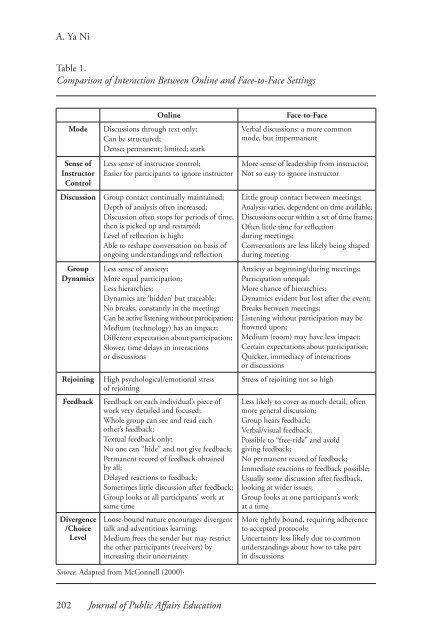Comparing the Effectiveness of Classroom and Online Learning ...
Comparing the Effectiveness of Classroom and Online Learning ...
Comparing the Effectiveness of Classroom and Online Learning ...
Create successful ePaper yourself
Turn your PDF publications into a flip-book with our unique Google optimized e-Paper software.
A. Ya Ni<br />
Table 1.<br />
Comparison <strong>of</strong> Interaction Between <strong>Online</strong> <strong>and</strong> Face-to-Face Settings<br />
Mode<br />
Sense <strong>of</strong><br />
Instructor<br />
Control<br />
Discussion<br />
Group<br />
Dynamics<br />
Rejoining<br />
Feedback<br />
Divergence<br />
/Choice<br />
Level<br />
<strong>Online</strong><br />
Discussions through text only;<br />
Can be structured;<br />
Dense; permanent; limited; stark<br />
Less sense <strong>of</strong> instructor control;<br />
Easier for participants to ignore instructor<br />
Group contact continually maintained;<br />
Depth <strong>of</strong> analysis <strong>of</strong>ten increased;<br />
Discussion <strong>of</strong>ten stops for periods <strong>of</strong> time,<br />
<strong>the</strong>n is picked up <strong>and</strong> restarted;<br />
Level <strong>of</strong> reflection is high;<br />
Able to reshape conversation on basis <strong>of</strong><br />
ongoing underst<strong>and</strong>ings <strong>and</strong> reflection<br />
Less sense <strong>of</strong> anxiety;<br />
More equal participation;<br />
Less hierarchies;<br />
Dynamics are ‘hidden’ but traceable;<br />
No breaks, constantly in <strong>the</strong> meeting;<br />
Can be active listening without participation;<br />
Medium (technology) has an impact;<br />
Different expectation about participation;<br />
Slower, time delays in interactions<br />
or discussions<br />
High psychological/emotional stress<br />
<strong>of</strong> rejoining<br />
Feedback on each individual’s piece <strong>of</strong><br />
work very detailed <strong>and</strong> focused;<br />
Whole group can see <strong>and</strong> read each<br />
o<strong>the</strong>r’s feedback;<br />
Textual feedback only;<br />
No one can “hide” <strong>and</strong> not give feedback;<br />
Permanent record <strong>of</strong> feedback obtained<br />
by all;<br />
Delayed reactions to feedback;<br />
Sometimes little discussion after feedback;<br />
Group looks at all participants’ work at<br />
same time<br />
Loose-bound nature encourages divergent<br />
talk <strong>and</strong> adventitious learning;<br />
Medium frees <strong>the</strong> sender but may restrict<br />
<strong>the</strong> o<strong>the</strong>r participants (receivers) by<br />
increasing <strong>the</strong>ir uncertainty<br />
Source. Adapted from McConnell (2000).<br />
Face-to-Face<br />
Verbal discussions: a more common<br />
mode, but impermanent<br />
More sense <strong>of</strong> leadership from instructor;<br />
Not so easy to ignore instructor<br />
Little group contact between meetings;<br />
Analysis varies, dependent on time available;<br />
Discussions occur within a set <strong>of</strong> time frame;<br />
Often little time for reflection<br />
during meetings;<br />
Conversations are less likely being shaped<br />
during meeting<br />
Anxiety at beginning/during meetings;<br />
Participation unequal;<br />
More chance <strong>of</strong> hierarchies;<br />
Dynamics evident but lost after <strong>the</strong> event;<br />
Breaks between meetings;<br />
Listening without participation may be<br />
frowned upon;<br />
Medium (room) may have less impact;<br />
Certain expectations about participation;<br />
Quicker, immediacy <strong>of</strong> interactions<br />
or discussions<br />
Stress <strong>of</strong> rejoining not so high<br />
Less likely to cover as much detail, <strong>of</strong>ten<br />
more general discussion;<br />
Group hears feedback;<br />
Verbal/visual feedback;<br />
Possible to “free-ride” <strong>and</strong> avoid<br />
giving feedback;<br />
No permanent record <strong>of</strong> feedback;<br />
Immediate reactions to feedback possible;<br />
Usually some discussion after feedback,<br />
looking at wider issues;<br />
Group looks at one participant’s work<br />
at a time<br />
More tightly bound, requiring adherence<br />
to accepted protocols;<br />
Uncertainty less likely due to common<br />
underst<strong>and</strong>ings about how to take part<br />
in discussions<br />
202 Journal <strong>of</strong> Public Affairs Education
















